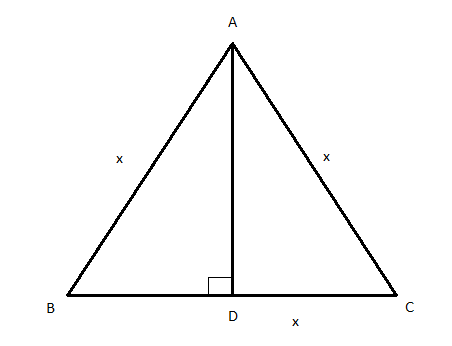
The Perimeter of an equilateral triangle is 6. The length of an altitude drawn on any of its sides is …….
A.
B.
C.
D.
Answer
502.2k+ views
Hint: It is given that the triangle is equilateral and perimeter is also given. So, first using perimeter we can find out the side of the triangle. The altitude bisects the base into two equal halves, hence using Pythagoras theorem we can find the height of the altitude.
Complete step by step answer:

Given perimeter of
All sides of an equilateral triangle are equal. Let the measure of each side be
Then
Therefore,
Hence, AB = BC = AC = 2
Let AD be the altitude drawn on BC from A.
Since, D is the midpoint of BC, we have
Now, in
By Pythagoras theorem we have
So, using Pythagoras theorem in
Therefore, the length of the altitude is equal to
So, the correct answer is “Option D”.
Note: Equilateral triangle means the triangle has all the sides equal and all the angles are equal. Isosceles triangle is one having two equal sides and two equal angles. Pythagoras theorem says the hypotenuse square is equal to the sum of squares of its base and altitude. For solving questions like above these things are to be kept in mind.
Complete step by step answer:

Given perimeter of
All sides of an equilateral triangle are equal. Let the measure of each side be
Then
Therefore,
Hence, AB = BC = AC = 2
Let AD be the altitude drawn on BC from A.
Since, D is the midpoint of BC, we have
Now, in
By Pythagoras theorem we have
So, using Pythagoras theorem in
Therefore, the length of the altitude is equal to
So, the correct answer is “Option D”.
Note: Equilateral triangle means the triangle has all the sides equal and all the angles are equal. Isosceles triangle is one having two equal sides and two equal angles. Pythagoras theorem says the hypotenuse square is equal to the sum of squares of its base and altitude. For solving questions like above these things are to be kept in mind.
Recently Updated Pages
How do you convert 572 inch into feet class 7 maths CBSE

Which bridge is the longest on the Konkan Railway route class 7 social science CBSE

Use the figure to name A Five points B A line C Three class 7 maths CBSE

Find five rational numbers between 1 and 1 class 7 maths CBSE

The cost of 5kg tomatoes is Rs80 What quantity of tomatoes class 7 maths CBSE

What is the equation for circumference class 7 maths CBSE

Trending doubts
Where did Netaji set up the INA headquarters A Yangon class 10 social studies CBSE

A boat goes 24 km upstream and 28 km downstream in class 10 maths CBSE

Why is there a time difference of about 5 hours between class 10 social science CBSE

The British separated Burma Myanmar from India in 1935 class 10 social science CBSE

The Equation xxx + 2 is Satisfied when x is Equal to Class 10 Maths

What are the public facilities provided by the government? Also explain each facility




